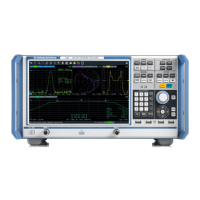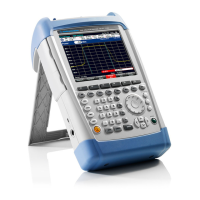Remote Control Commands
R&S
®
SGS100A
213User Manual 1173.9105.02 ─ 12
11.9 MMEMory Subsystem
The MMEMory subsystem (Mass Memory) contains the commands for managing files
and directories as well as for loading and storing complete instrument settings in files.
The files are stored on the internal flash memory of the instrument or on external USB
memory devices.
The default directory is determined using the command MMEMory:CDIR.
Use the command :SYSTem:MMEMory:PATH:USER? to query the path of the direc-
tory for user-defined data.
The /opt directory is a protected and therefore a not accessible system directory. The
files on this directory contain data that must not be changed. Therefore, this directory
should not be accessed, since reconstruction of the system partition will lead to data
loss.
11.9.1 File Naming Conventions
To enable files in different file systems to be used, the following file naming conven-
tions should be observed.
The file name can be of any length and is case-sensitive, meaning it is distinguished
between uppercase and lowercase letters.
The file and the optional file extension are separated by a dot. All letters and numbers
are permitted (numbers are, however, not permitted at the beginning of the file name).
If possible, special characters should not be used. The use of the slashes "\" and "/"
should be avoided since they are used in file paths. A number of names are reserved
for the operating system, e.g. CLOCK$, CON, AUX, COM1...COM4, LPT1...LPT3, NUL
and PRN.
In the R&S SGS all files in which lists and settings are stored are given a characteristic
extension. The extension is separated from the actual file name by a dot (see Chap-
ter 11.9.2, "Extensions for User Files", on page 214 for an overview of the file types).
The two characters "*" and "?" function as "wildcards", meaning they are used for
selecting several files. The "?" character represents exactly one character, while the "*"
character represents all characters up to the end of the file name. "*.*" therefore stands
for all files in a directory.
When used in conjunction with the commands, the parameter <file_name> is speci-
fied as a string parameter with quotation marks. It can contain either the complete path
including the drive, only the path and the file name, or only the file name. The file name
must include the file extension. The same applies for the parameters
<directory_name> and <path>.
MMEMory Subsystem

